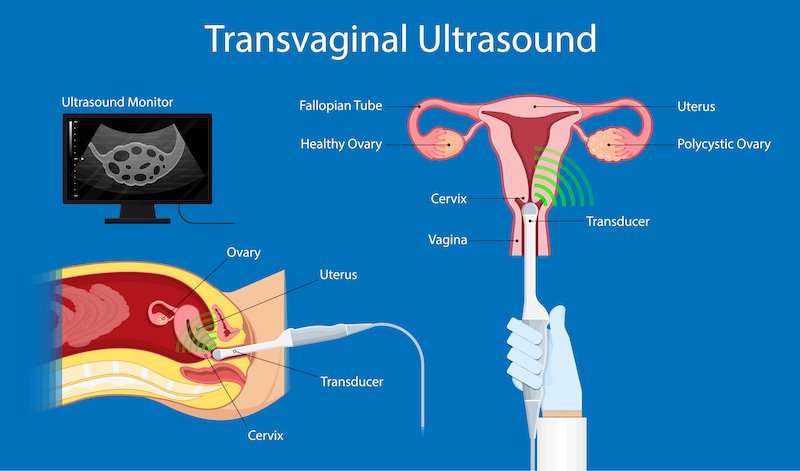
Transvaginal ultrasound
A transvaginal ultrasound is a diagnostic imaging procedure used to examine the female reproductive organs, including the uterus, ovaries, cervix, and fallopian tubes. Unlike a traditional abdominal ultrasound, which is performed externally, a transvaginal ultrasound involves inserting a small ultrasound probe into the vagina to obtain high-resolution images of the pelvic organs.
Why is a Transvaginal Ultrasound Performed?
Evaluating Pelvic Pain or Abnormal Bleeding
If you’re experiencing unexplained pelvic pain, irregular menstrual bleeding, or postmenopausal bleeding, a transvaginal ultrasound can help identify potential causes, such as fibroids, polyps, or ovarian cysts.
Assessing Fertility Issues
For women struggling with infertility, this ultrasound can provide detailed information about the uterus and ovaries, including the thickness of the uterine lining, the presence of ovarian follicles, and any structural abnormalities that may affect conception.
Monitoring Pregnancy
During early pregnancy, a transvaginal ultrasound is often used to confirm the pregnancy, check the gestational age, and monitor the health of the embryo. It can also detect ectopic pregnancies or miscarriages.
Diagnosing Gynecological Conditions
This procedure is commonly used to diagnose conditions such as endometriosis, pelvic inflammatory disease (PID), ovarian cysts, and uterine fibroids.
Guiding Medical Procedures
A transvaginal ultrasound may be used to guide certain medical procedures, such as egg retrieval for in vitro fertilization (IVF) or the placement of an intrauterine device (IUD).
How to Prepare for a Transvaginal Ultrasound
- Clothing: Wear comfortable, loose-fitting clothing to your appointment. we may asked to change a hospital gown.
- Bladder: Unlike an abdominal ultrasound, a full bladder is not required for a transvaginal ultrasound. In fact, you may be asked to empty your bladder before the procedure.
- Timing: If the ultrasound is being performed to evaluate fertility or menstrual issues, your doctor may schedule it at a specific time during your menstrual cycle.
- Communication: Inform your healthcare provider if you have any allergies, medical conditions, or concerns about the procedure.
What Happens During the Procedure?
- Preparation: You’ll be asked to lie on an examination table with your feet in stirrups, similar to a pelvic exam.
- Probe Insertion: The ultrasound technician (sonographer) will cover a small, wand-like transducer probe with a sterile cover and lubricating gel. The probe is then gently inserted into the vagina.
- Imaging: The probe emits sound waves that create real-time images of your pelvic organs on a monitor. The sonographer may move probe slightly for capture different angles.
- Completion: Once the necessary images are obtained, the probe is removed, and the procedure is complete.
Benefits of a Transvaginal Ultrasound
- High-Quality Images: The close proximity of the probe to the pelvic organs allows for highly detailed and accurate images.
- Non-Invasive: Unlike surgical procedures, a transvaginal ultrasound does not require incisions or anesthesia.
- Safe and Painless: The procedure is safe for most women and is not associated with any significant risks or side effects.
- Versatile: It can be used for a wide range of diagnostic and monitoring purposes.
Risks and Limitations
- Discomfort: Some women may experience mild discomfort or pressure during the procedure.
- Limited Scope: The ultrasound primarily focuses on the pelvic region and may not provide information about other areas of the body.
- Not Suitable for All Patients: In rare cases, such as for women with certain medical conditions or anatomical abnormalities, alternative imaging methods may be recommended.Contact Us
Conclusion
A transvaginal ultrasound is a valuable diagnostic tool that provides detailed insights into the health of your reproductive organs. Whether you’re investigating pelvic pain, monitoring a pregnancy, or assessing fertility, this procedure is safe, effective, and minimally invasive. By understanding what to expect and how to prepare, you can approach your appointment with confidence.Schedule your Consultation with Dr. Ritesh Nawkhare
